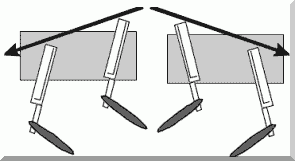Honing, introduction

The purpose of honing is to restore the edge. This means that the
result must be that the edge sides almost meet at a point again.
Given the fact that an edge will allways be serrated, the strokes
should be diagonally with a constant angle in order to sharpen
these teeth, according to the Standard Textbook of Barbering. The
paragraph below refers to that book too. The angles also should be
equal at strokes in both directions, in order to set the teeth
symmetrical.
The razor must be stroked edge-first and diagonally, as the figure shows. The angles and pressure should be equal in both directions, and the pressure should be equal from heel to point, to keep a straight edge from heel to point, and to ensure equal bevels on both sides of the edge.
The razor must be kept perfectly flat while the strokes are made, for if the razor is rocked the least bit, the bevel will become uneven in time, and the result will be a crooked edge instead of one that is perfectly parallel. The edge must never touch the hone in a backward stroke when putting it in position for the second movement.
Before beginning, one should master the technique of turning the razor without turning the wrist. This makes a world of difference in keeping the razor in perfect condition. The first step is to place the razor with the heel on the hone, and back at a slight angle to the right end of the hone, as in the scheme at the right.
Draw the razor diagonally across the hone along the arrow. When
this stroke is completed, turn the razor on its back, and at the
same time move it up to prepare for the next stroke into the
opposite direction. Repeat these movements slowly, attending
carefully to the rules given above. If the razor is quite dull, the
honing should be first executed with a firm pressure, easing upon
the pressure as the razor takes its edge. Experience will guide you
in this. Start excercising on a slow hone with an old razor, until
the process of honing has become an easy and free muscular act. It
is important to acquire correct technique at first, for speed will
come naturally with practice.